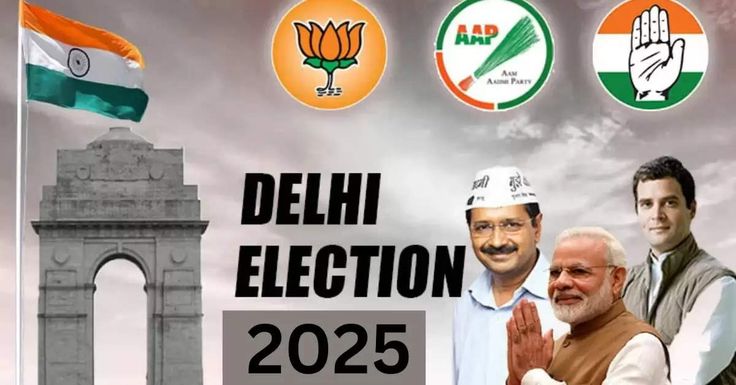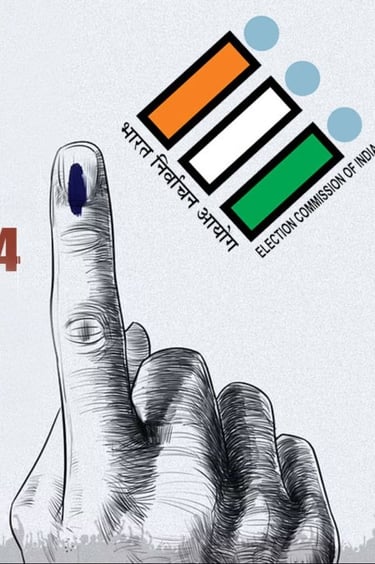Delhi elections 2025
AAP, BJP and Congress in the spotlight
POLITICS
1/16/20254 min read
Delhi Elections 2025: AAP, BJP, and Congress in the Spotlight
As Delhi gears up for the 2025 Legislative Assembly elections, the battle for power is intensifying among three major political players: the Aam Aadmi Party (AAP), the Bharatiya Janata Party (BJP), and the Indian National Congress (INC). While AAP and BJP are the main contenders, Congress is striving to regain relevance in Delhi's political landscape. This article delves into the promises, governance records, and public sentiment surrounding these parties, focusing particularly on AAP’s unfulfilled promises and BJP’s strategy, while also exploring Congress's stance and vision.
AAP’s Governance: Broken Promises and Challenges
Since its landslide victory in 2020, the AAP government has been under increasing scrutiny for failing to deliver on its promises. Key Issues:
1. Water and Electricity Woes: Despite promises of 24/7 water supply and free electricity, many areas in Delhi continue to face water shortages and irregular power supply.
2. Pollution Crisis: Delhi remains one of the world’s most polluted cities. The AAP’s much-touted initiatives like the odd-even vehicle scheme and anti-dust campaigns have had limited impact.
3. Corruption Allegations: AAP's liquor policy scandal has tainted its image, with high-profile arrests and a resignation by Arvind Kejriwal in 2024.
4. Education and Healthcare: While AAP claims success in these sectors, many schools and hospitals still lack adequate infrastructure and resources, falling short of the promised transformation.
BJP’s Renewed Vision: Aiming for Change
After decades without power in Delhi, the BJP is mounting a robust campaign against AAP, focusing on governance issues and corruption. BJP’s Key Strategies:
Pollution Control: The BJP plans to introduce sustainable measures, such as stricter vehicular emission norms and green infrastructure projects.
Infrastructure Development: Promises include upgrading Delhi’s public transport, improving road connectivity, and addressing the Yamuna river's pollution.
Economic Growth: Proposals to boost employment through industrial hubs and support for small businesses aim to address Delhi’s rising unemployment rate.
Anti-Corruption Drive: The BJP’s campaign highlights transparency and efficiency, contrasting its governance model with AAP’s controversies.
Public Sentiment and Surveys
Recent surveys reveal a complex mix of opinions among Delhi voters:
Discontent with AAP: Many residents feel betrayed by AAP’s inability to address pollution, water scarcity, and rising costs. A 2024 survey by Lokniti-CSDS found that 45% of respondents were dissatisfied with AAP's governance.
Support for BJP’s Vision: The BJP is gaining traction, particularly among youth and middle-class voters, who are drawn to its developmental agenda and anti-corruption stance.
Congress’s Revival Hopes: While Congress remains a distant third, its focus on social welfare resonates with older voters and economically weaker sections.
Opinion Poll Projections
1. Phalodi Satta Bazar Predictions: The Phalodi Satta Bazar, a well-known betting market, has released its initial projections for the Delhi elections. According to their analysis, there is an anticipated significant decline in AAP's seat tally compared to the previous election. While the exact numbers are not specified, this suggests a potential shift in voter sentiment away from AAP.
2. BJP's Vote Share Stability: Despite not securing a victory in Delhi Assembly elections since 1998, the Bharatiya Janata Party (BJP) has maintained a consistent vote share over the years. In the 2020 elections, the BJP secured 38.51% of the vote, resulting in 8 seats. This stability indicates a steadfast support base, which the party aims to expand in the upcoming elections.
3. Congress's Position: The Indian National Congress (INC) has struggled in recent Delhi elections, failing to secure any seats in the 2020 Assembly elections with a mere 4% vote share. However, the party is attempting a resurgence by fielding candidates in multiple constituencies and focusing on issues pertinent to Delhi's electorate.
Caste-Based Perspectives
Scheduled Castes (SC) and Scheduled Tribes (ST): Traditionally, these groups have leaned towards parties advocating for social justice and affirmative action. AAP's initiatives in education and healthcare have garnered support; however, unmet promises and governance issues have led to growing disenchantment. The BJP is attempting to make inroads by emphasizing economic empowerment and social inclusion.
Other Backward Classes (OBC): Comprising a significant portion of Delhi's electorate, OBC voters have shown varied allegiances. AAP's focus on public services initially attracted this demographic, but recent controversies have caused some to reconsider their support. The BJP is courting OBC voters by highlighting national development schemes and promising local economic opportunities.
General Category: Voters from the general category, including upper castes, have diverse political inclinations. While some appreciate AAP's governance model, others are critical of its administrative lapses. The BJP is appealing to this group through promises of improved infrastructure and economic growth.
Conclusion: A Decisive Moment for Delhi
The 2025 Delhi elections are shaping up to be a three-way contest that could redefine the city’s political future. While AAP faces backlash for its governance failures, BJP’s promises of transparency and development resonate with many. Congress, though weakened, is making efforts to reconnect with voters through its legacy and social welfare agenda.
Delhi’s citizens have a critical decision to make: whether to continue with AAP, opt for BJP’s developmental approach, or give Congress another chance. The outcome will not only shape Delhi’s governance but also send a strong message about the public’s expectations from its leaders.



